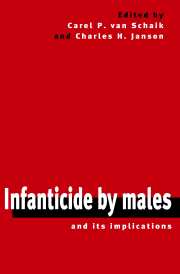Book contents
- Frontmatter
- Contents
- List of Contributors
- Foreword
- Infanticide by males: prospectus
- Part I Introduction
- 1 The holy wars about infanticide. Which side are you on? and why?
- 2 Infanticide by male primates: the sexual selection hypothesis revisited
- 3 Vulnerability to infanticide by males: patterns among mammals
- Part II Infanticide by males: case studies
- Part III Behavioral consequences of infanticide by males
- Part IV Infanticide by females
- Part V Conclusion
- References
- Species index
- Subject index
1 - The holy wars about infanticide. Which side are you on? and why?
Published online by Cambridge University Press: 04 November 2009
- Frontmatter
- Contents
- List of Contributors
- Foreword
- Infanticide by males: prospectus
- Part I Introduction
- 1 The holy wars about infanticide. Which side are you on? and why?
- 2 Infanticide by male primates: the sexual selection hypothesis revisited
- 3 Vulnerability to infanticide by males: patterns among mammals
- Part II Infanticide by males: case studies
- Part III Behavioral consequences of infanticide by males
- Part IV Infanticide by females
- Part V Conclusion
- References
- Species index
- Subject index
Summary
Introduction
The topic of infanticide has been a staple theorem of sociobiology ever since this discipline – the study of social behavior from an evolutionary perspective – was born two and a half decades ago (Wilson 1975). The killing of conspecific young is still hotly debated. Does it occur at all, does it reflect an adaptation, a pathology or even a political agenda? Infanticide – observed among such varied taxa as birds, rodents, carnivores, pinnipeds and primates (Hausfater & Hrdy 1984; Parmigiani & vom Saal 1994) – therefore remains a litmus test upon which the validity of a sociobiological interpretation of behavior depends. I attempt to trace some intellectual roots of the controversy: those of defenders of adaptationist explanations, those of critics from within the paradigm of evolutionary biology, and those of critics who operate from other paradigms such as the social sciences. My ultimate aim is to defend the adaptationist interpretation as a valid and fruitful approach, while acknowledging that its narrative is anchored in a time-dependent framework of interpretation.
Cute and brute
People are fascinated by animals, not least because people are, in their own right, animals who can empathize with similar organisms. The average viewer of a natural history documentary will feel good if a monkey mother cuddles her newborn: “It's so cute.” But different emotions flare up if, over television dinner, wild chimpanzees eat an infant of their own kind: “It's so brute.”
- Type
- Chapter
- Information
- Infanticide by Males and its Implications , pp. 9 - 26Publisher: Cambridge University PressPrint publication year: 2000
- 20
- Cited by

